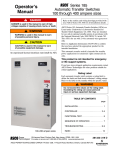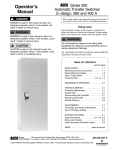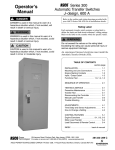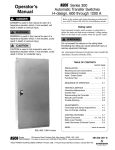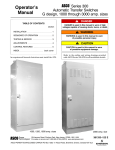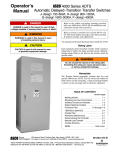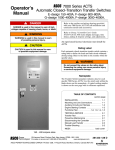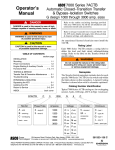Download Emerson ASCO 185 Series Operator`s manual
Transcript
Operator’s Manual Series 185 Automatic Transfer Switches 100 through 400 ampere sizes DANGER is used in this manual to warn of a hazard situation which, if not avoided, will result in death or serious injury. WARNING is used in this manual to warn of a hazardous situation which, if not avoided, could result in death or serious injury. CAUTION is used in this manual to warn of a hazardous situation which, if not avoided, could result in minor or moderate injury. An experienced licensed electrician must install the ATS. Refer to the outline and wiring drawings provided with your ASCO Series 185 ATS for all installation details. ASCO Series 185 Automatic Transfer Switches (ATSs) are Listed under Underwriter’s Laboratories Standard for Transfer Switch Equipment, UL–1008. They are intended for use only in optional standby systems in accordance with the National Electrical Code, NEC/NFPA 70, Article 702. This ATS is for use with 2–wire automatic–start generators only. Refer to Application Information 381339–292 to confirm that you have selected the appropriate product for the intended installation. This automatic transfer switch is intended for standby power applications in residential / light commercial use only. This product is not intended for emergency or life–support systems. If you have more stringent application requirements contact ASCO Power Technologies for other products suitable for critical applications. Rating Label Each automatic transfer switch contains a rating label to define the loads and fault circuit withstand / closing ratings. Refer to the label on the transfer switch for specific values. Do not exceed the values on the rating label. Exceeding the rating can cause person injury or serious equipment damage. TABLE OF CONTENTS page INSTALLATION . . . . . . . . . . . . . . . . . . . . . . . . . . 1 CONTROLLER . . . . . . . . . . . . . . . . . . . . . . . . 2–5 FUNCTIONAL TEST . . . . . . . . . . . . . . . . . . . . . . 6 SEQUENCE OF OPERATION . . . . . . . . . . . . . 7 TROUBLESHOOTING . . . . . . . . . . . . . . . . . . 8–9 100–230 ampere sizes INDEX . . . . . . . . . . . . . . . . . . . . . . . . . . . . . . . . . 10 50 Hanover Road, Florham Park, New Jersey 07932–1591 USA For sales or service call 1 800 800–2726 (ASCO) www.ascopower.com 381333–319 E ASCO POWER TECHNOLOGIES CANADA PO Box 1238, 17 Airport Road, Brantford, Ontario, Canada N3T 5T3 Series 185 Catalog Number Identification Nameplate The Transfer Switch nameplate includes data for each specific ASCO Series 185 ATS. Use the ATS only within the limits shown on this nameplate. D 185 Neutral A – standard A Phase Poles 2 – single Ø clock battery 2 A typical Catalog Number is shown below with its elements explained. The example is for a D–design, 2 pole, 200 A, 220–240 V, in Type 1 indoor enclosure: 200 F Amperes 100 200 230 260 400 4 Voltage F 220--- 240 C Controller Enclosure 4 – standard C – Type 1 M – Type 3R 4X – if accessories ordered load power connections cable spacers (see INSTALLATION) emergency power connections neutral connections terminals for optional switch position contacts (shown installed) Transfer Switch ground connections membrane controls generator control connections Controller harness plug utility power connections 200 ampere size in typical enclosure with location of customer connections 381333–319 E INSTALLATION Installation of the ASCO Series 185 automatic transfer switch (ATS) must be performed by a licensed electrician. It must be installed according to the National Electrical Code (NEC) and all local electrical code requirements. Remove the enclosure cover and inspect the ATS for shipping damage. If damage is evident do not install the ATS. 1 --- Mounting Refer to the enclosure outline drawing. Mount the ATS according to details and instructions shown on this diagram. Mount the ATS vertically to a rigid supporting structure. Level all mounting points by using flat washers behind the holes to avoid distortion of the enclosure. Series 185 2 --- Electrical Power Connections Refer to the wiring diagram. The ATS must be protected by suitably sized circuit breakers feeding the utility and generator source terminals. The rating of the circuit breakers must be based on the requirements of the National Electrical Code for its nameplate ampere and short circuit withstand ratings. ELECTROCUTION HAZARD Turn off utility power and turn off the generator to prevent electrocution when wiring the transfer switch. Cable Spacers for 150, 200, and 230 A NOTICE Three cable spacers are included with 150, 200, and 230 ampere transfer switches. Run the copper power cables through the cable spacers as shown in Figure 2. Position the cable spacers approximately 1½ inches from the terminal lugs. MALFUNCTION or SHORTENED LIFE Protect the automatic transfer switch from construction grit and metal chips to prevent malfunction or shortened life of the ATS. NOTICE Transfer switches rated 260 and 400 amperes are mounted on an insulator backing piece (installed behind the transfer switch). If the transfer switch is removed from the enclosure and then reinstalled, this insulator must be placed behind the transfer switch. See Figure 1. CABLE LOOSENING DUE TO SHORT CIRCUIT Install three cable spacers 1 1/2 inches from the power terminals to prevent the cables from loosening during a short–circuit condition on 150, 200, and 230 ampere transfer switches. cable spacers FLASH HAZARD – DAMAGE Be sure that the insulator piece is installed behind the 260 and 400 ampere transfer switches. insulator backing piece 1 ½ inch approximate use copper power cables only for 200 and 230 A cable spacer Figure 2. Cable spacers for 150, 200, and 230 A. Figure 1. Insulator for 260 and 400 A. 1 381333–319 E CONTROLLER Series 185 1 --- Push Buttons The Group 4 digital Controller is used in ASCO Series 185 automatic transfer switches. It provides the sensing, timing, and control functions for the ATS. This micro– processor–based controller includes built–in control buttons and status lights for control of the ATS and generator. On the front control display are three push buttons that control the operation of the generator and the ATS. Before using the transfer test button, be sure that conditions are safe for running the generator and for load transfer. clock battery cover see page 3 Transfer Test Use this button to test the system. This operation starts the generator and transfers the load. Be sure that conditions are safe to do this operation. Bypass Time Delay Use this button to cancel the active time delay or exercise period (stops the generator after cooldown). Utility Acceptable light Transfer Test button Set Engine Exerciser Use this button to set the automatic generator exerciser (page 3). Load on Utility light 2 --- Indicator Lights Bypass Time Delay button On the front control display are five lights that indicate the status of the sources and the ATS. Set Engine Exerciser button Load on Generator light Automatic Generator Exerciser light Utility Acceptable This light indicates that the utility voltage is acceptable for connection to the load. Generator Acceptable light Generator Acceptable This light indicates that the generator voltage is acceptable for connection to the load. Figure 3. Front view of controller. Load on Utility This light indicates that the load is connected to the utility. Load on Generator This light indicates that the load is connected to the generator. Automatic Generator Exerciser This light indicates the status of the generator exerciser: --- blinks during the exercise period (including cooldown). --- stays on when the exerciser has been set. --- is off when the exerciser has not been set. 381333–319 E 2 CONTROLLER (continued) Series 185 3 --- Generator Starting Contacts 5 --- Automatic Generator Exerciser The generator starting contacts connections are on the controller. Refer to the generator manual. Disconnect the generator battery and verify that the ignition switch is in the OFF position. Connect the generator starting wires to the appropriate terminals on terminal block TB7 as shown on the wiring diagram. For wiring convenience terminal block TB7 has a removable plug. See Figure 4 and Table A. The built–in automatic generator exerciser can be set to exercise the generator for 20 minutes once every week. Clock Battery Be sure a fresh battery is installed and turned on. It will maintain the exerciser clock for about 24 hours in case of a power outage. Recommended 9 volt alkaline batteries are (see Figure 5): Duracell MN 1404, Everready 522, Panasonic 6AM6 Turn on battery by putting S2 DIP switch actuator 10 in the on position (up). See Table B and Figure 6. 1 2 3 4 5 6 7 8 9 Exercise with or without Load TB7 removable terminal block Figure 4. TB7 generator starting contact terminals. The generator should be exercised under load or follow the recommendations of the generator manufacturer. Be sure the exerciser is turned on. Then select either exercise with or without load. The ATS will transfer the load to the generator when the exercise with load is selected. See Figure 6 and Table B. Table A. Generator Start Connections Table B. Generator Exercise Settings TB7–4, TB7–5, TB7–6 When the Utility fails Terminals on Controller Function Factory Setting DIP Switch DIP Actuator contact closes TB7–4 and TB7–5 contact opens TB7–5 and TB7–6 clock battery off S2 10 exerciser off S1 7 with load or without load without load S1 8 4 --- Settings The time delay and sensor setting in the Group 4 controller are accessible on the inside. Refer to Tables B and C and to Figures 6 and 7. Use a ball–point pen or other pointed tool to slide the DIP switch actuators up or down to match setting shown. Actuator Position on (up) off (down) on (up) off (down) with (up) without (down) To Set Exerciser Press and hold (5 seconds) the Set Engine Exerciser button. The exercise period occurs immediately and at approximately the same time weekly thereafter. The status light below the button blinks during the exercise period (including the cooldown). The light stays on to indicate that the exerciser has been set. If the light is off, the exerciser has not been set. All power must be off before making any changes. The factory default settings are shown in Table G on page 5. To Cancel an Active Exercise Period cover must be removed to replace 9V battery (use alkaline type) Press the Bypass Time Delay button to stop an exercising generator. If exercise with load is set, the ATS retransfers the load to the utility, then stops the generator after cooldown. screw Figure 5. Battery replacement. 3 381333–319 E CONTROLLER (continued) Series 185 S1 DIP switch S3 DIP switch S2 DIP switch Figure 6. DIP switches S1 and S2 at the top right. The time delay settings are shown in Figures 6 and 7 and in Table C. The sensor settings are shown in Figure 6 and in Table D. The standard (factory) settings are shown in Tables C, D, and H. Figure 7. DIP switch S3 at the bottom center. Table C. Time Delay Settings Time Delay Description Factory Setting override momentary utility outages 3 seconds transfer to generator 10 seconds (approx.) override momentary generator outages 4 seconds transfer to utility 5 minutes (approx.) unloaded running (generator cooldown) 2 minutes load disconnect delay before transfer (and delay after transfer, if enabled) 0 seconds Settings DIP Switch DIP Actuator Actuator Position 1 second S2 1 on (up) 3 seconds S2 1 off (down) – – – – 4 second S3 9 on (up) 0 S3 9 off (down) – – – – 2 minutes S1 10 on (up) 5 minutes S1 10 off (down) 0 seconds S3 7, 8 both on (up) 3 seconds S3 7, 8 7 on (up), 8 off (down) 10 seconds S3 7, 8 7 off (down), 8 on (up) 20 seconds S3 7, 8 both off (down) Table D. Voltage and Frequency Settings Setting Description voltage frequency phase Setting Factory Setting Settings DIP Switch DIP Actuator Actuator Position – 220 – 240 V non–adjustable S2 2 on (up) nominal 60 Hz 50 Hz S1 4 on (up) – single pickup 198 V 60 Hz S1 4 off (down) non–adjustable S1 6 on (up) 198 V S1 3 on (up) 209 V * S1 3 off (down) S1 1 off (down) S1 2 off (down) S1 1 on (up) S1 2 off (down) S1 1 off (down) S1 2 on (up) S1 1 on (up) S1 2 on (up) non adjustable non–adjustable – – – non adjustable non–adjustable – – – 198 V * utility voltage 187 V dropout 187 V 176 V 154 V generator voltage generator frequency pickup 198 V dropout 165 V pickup 57 Hz (nom 60 Hz) 48 Hz (nom 50 Hz) dropout 51 Hz (nom 60 Hz) 43 Hz (nom 50 Hz) * If the dropout voltage is set to 198 V, the pickup voltage must be set to 209 V. 381333–319 E 4 CONTROLLER (continued) 7 --- Factory Settings --- Summary 6 --- Remote Control & Load Disconnect Table H. Factory Settings – Summary These remote control features require a customer– supplied normally–closed contact suitable for a 5 V dc low energy circuit. Refer to the wiring diagram provided with the ATS. Activate the appropriate DIP switch S3 actuators as shown in Tables E, F, or G. See Figure 7. DIP Switch DIP Actuator Actuator Position 1 on (up) 2 off (down) 3 on (up) 4 off (down) 5 off (down) 6 on (up) 7 off (down) 8 off (down) Remote test Normally–closed input. When opened, it simulates a utility failure. The generator is signalled to start immediately and the load transfers to the generator (if acceptable). If the generator fails, the load stays on the generator until the remote test circuit is closed. S1 Table E. Remote test Function Factory Setting DIP Switch DIP Actuator disabled enabled disabled (on) S3 3 Actuator Position on (up) off (down) Remote test (with automatic retransfer) S2 Normally–closed input. When opened, it simulates a utility failure. The generator is signalled to start immediately and the load transfers to the generator (if acceptable). If the generator fails, the load transfers back to the utility (if acceptable). Table F. Remote transfer to generator Function Factory Setting disabled enabled disabled (on) DIP Switch S3 DIP Actuator 2 Actuator Position on (up) off (down) Bypass load transfer to utility time delay S3 Normally–closed input. When opened, it bypasses or cancels the generator to utility load transfer time delay. The load transfers back to the utility. Table G. Bypass load transfer to utility delay Function Factory Setting DIP Switch DIP Actuator disabled enabled disabled (on) S3 1 Series 185 Actuator Position on (up) off (down) 9 off (down) 10 on (up) 1 off (down) 2 on (up) 3 off (down) 4 on (up) 5 on (up) 6 on (up) 7 on (up) 8 on (up) 9 off (down) 10 off (down) 1 on (up) 2 on (up) 3 on (up) 4 on (up) 5 on (up) 6 off (down) 7 on (up) 8 on (up) 9 on (up) 10 on (up) Table I. Load disconnect delay before transfer Load disconnect feature Connect external circuits to the terminals indicated on the wiring diagram. The double throw (Form C) contact operates prior to a selectable 0, 3, 10, or 20 second delay before transfer of the ATS. The contact resets either immediately following transfer or after the same delay as set for presignal before transfer. Time delay between the load disconnect control signal and initiation of transfer is set on the controller DIP switch S3 (actuators 6, 7, 8). Function Factory Setting DIP Switch 0 seconds disabled S3 3 seconds S3 10 seconds S3 20 seconds S3 DIP Actuator 7 8 7 8 7 8 7 8 Actuator Position on (up) on (up) on (up) off (down) off (down) on (up) off (down) off (down) Table J. Load disconnect delay after transfer* Function * Enabling the delay after transfer will cause the control signal to reset after the same delay as set for the delay before transfer. disabled enabled 5 Factory Setting disabled DIP Switch S3 S3 DIP Actuator 6 6 Actuator Position off (down) on (up) 381333–319 E Series 185 FUNCTIONAL TEST After installing the Series 185 automatic transfer switch (ATS) perform the following three–part functional test. maintenance handle With ALL POWER OFF grasp maintenance handle and turn it quickly with your thumb and fingers. 1 --- Manual Operation A handle is provided on the transfer switch for maintenance purposes only. Manual operation of the transfer switch should be checked before it is energized (operated electrically). weight marked P (utility) and A (generator) Figure 8. Maintenance handle for 100–230 A. Do not manually operate the transfer switch until both power sources are disconnected: open both circuit breakers. 1. Turn OFF both the utility and generator circuit breakers feeding the ATS. Verify that ALL POWER IS OFF! 2. 100–230 A Grasp the maintenance handle and turn it quickly with your thumb and fingers to manually operate the transfer switch. 260–400 A Insert the maintenance handle into the hole in the shaft, left side of the operator. Move the handle as shown to manually operate the transfer switch. 3. 4. hole shaft Figure 9. Maintenance handle for 260–400 A. 3 --- Electrical Operation This procedure checks the electrical operation of the ATS. The switch should operate smoothly without binding. If it does not, check for shipping damage or construction debris. After checking the manual operation, use the handle again to return the transfer switch to the utility source position. 100–230 A see Figure 8. The letter P (utility) on the round weight is facing you. 260–400 A see Figure 9. The letter N (utility) on the round weight is facing you. Remove the maintenance handle and store it on the transfer switch in the place provided. NOTICE 260–400 A Remove the maintenance handle before proceeding! 2 --- Voltage Checks The ATS is rated for 220–240 V ac 60 or 50 Hz. Verify that both the utility and generator sources are 220–240 V ac 60 or 50 Hz. 381333–319 E maintenance handle 1. Install the enclosure cover and tighten the screws. 2. Verify that the generator battery is connected and that the generator’s starting controls are set for automatic. 3. Turn on both the utility and generator circuit breakers. 4. Verify that the Utility Acceptable and Load on Utility lights are on. 5. This step will start the generator. Press and hold the Transfer Test button until the Generator Acceptable light comes on and stays on. Then release the button. 6. After the Generator Acceptable light comes on, the ATS transfers the load from the utility to the generator (after approx. 10 second delay). The Load on Generator light comes on. 7. The ATS stays connected to the generator for 5 minutes (approx.). The utility must be acceptable for 5 minutes continuously. Then the load is transferred back to the utility. To bypass time delay, press the Bypass Time Delay button. 8. After load retransfer to utility, the generator runs 2 minutes (without load), then shuts down. The Generator Acceptable light goes off indicating that the generator is off. This completes the Functional Test. 6 Sequence of Operation --- Utility Failure Series 185 light is on light is off ¡ generator stops Utility power good. Electrical loads on utility generator runs unloaded for 2 min. utility acceptable Utility fails (longer than 3 sec.) load on utility ¥ electrical loads switched back to utility © utility acceptable generator off load on utility wait 5 min. for utility to stabilize generator acceptable utility acceptable start generator utility off observe these power lights observe these switch lights load off generator off generator starting utility off load on utility load on generator utility off generator acceptable ¤ utility returns load on generator waiting for utility to return generator acceptable ¢ generator acceptable wait 10 sec. for generator to warm up generator acceptable £ electrical loads switched to generator 7 381333–319 E TROUBLESHOOTING Series 185 This troubleshooting guide describes some of the simple causes of problems with the installation of the automatic transfer switch. Troubleshooting beyond the scope of this guide should not be attempted by the installer. A licensed electrician must perform all internal troubleshooting. ASCO Power Technologies can be contacted at: 1–800–800–2726 or [email protected] Problem The Utility Acceptable light 1. does not come on when utility 2. power is connected to the ATS. 381333–319 E With ALL POWER OFF, verify that the utility feed is 220–240 V ac and 60 Hz. Check DIP switch S2 actuator 2, and DIP S1 actuator 4. See Table D for voltage and frequency settings. With ALL POWER OFF, verify that the utility feed is wired to the terminal lugs on the bottom of the transfer switch marked L1 and L5. See the wiring diagram. 4. With ALL POWER OFF, verify that the transfer switch harness is connected properly to the controller (plug and receptacle tight). Hold the Transfer Test button for at least 15 seconds. Verify that the generator starting controls are set for automatic operation (not in manual mode). Verify that the generator battery is connected and that the battery voltage meets the generator manufacturer’s recommendation. 4. Verify that the correct contact (normally open or normally closed) is being utilized (see the generator manual). 5. With ALL POWER OFF, verify engine start low voltage wiring between the controller terminal block and the generator. See the wiring diagram. Check that the plug is properly seated in the receptacle on the controller. Verify proper generator operation (fuel in tank, oil level, spark plugs --- see generator manual). The generator cranks but does 1. not start and run when the utility source fails or when the Transfer Test button is pressed. 2. The generator starts and runs but the ATS does not transfer the load to the generator. Cause and Solution Verify that the utility feed is connected and that its circuit breaker is ON. 3. The generator does not crank 1. when the utility source fails or 2. when the Transfer Test button is pressed. 3. The generator starts and runs but the Generator Acceptable light does not come on. ELECTROCUTION FLASH HAZARD Do not work on the transfer switch until both the utility and generator are off. Turn OFF both circuit breakers. 1. With ALL POWER OFF, verify engine start low voltage wiring between the controller terminal block and the generator. See the wiring diagram. Check that the plug is properly seated in the receptacle. Verify that the generator feed is connected and that its circuit breaker is ON. 2. With ALL POWER OFF, verify that the generator feed is 220–240 V ac and 60 Hz. Check DIP switch S2 actuator 2, and DIP S1 actuator 4. See Table D for voltage and frequency settings. 3. With ALL POWER OFF, verify that the generator feed is wired to the terminal lugs on the top of the transfer switch marked L2 and L6. See the wiring diagram. 4. With ALL POWER OFF, verify that the transfer switch harness is connected properly to the controller (plug and receptacle tight). 5. 1. Verify generator ac output (voltage and frequency --- see generator manual). Verify that the Generator Acceptable light is on. If it is off, see previous troubleshooting problem. The ATS will not transfer the load to an unacceptable source. 2. With ALL POWER OFF, verify that the transfer switch harness is connected properly to the controller (plug and receptacle tight). 8 TROUBLESHOOTING (continued) Series 185 Problem The ATS does not immediately 1. transfer the load to the generator. 2. Cause and Solution Verify that the Generator Acceptable light is on. If it is off, see previous troubleshooting problem. The ATS will not transfer the load to an unacceptable source. 3. 1. Press the Bypass Time Delay button for immediate load transfer to the generator. The generator may be overloaded. Check to see if the generator circuit breaker tripped. Check the sum of the loads to be sure it does not exceed the capacity of the generator. Some motor loads require three times more power for starting. 2. Check for short circuit in a connected load. 3. 1. Observe the Load on Utility and Load on Generator lights. Verify proper generator operation; it may have run out of fuel or shut down because of low oil level (see generator manual). 2. The generator may be overloaded. Check to see if the generator circuit breaker tripped. Check the sum of the loads to be sure it does not exceed the capacity of the generator. Some motor loads require three times more power for starting. 3. Check for short circuit in a connected load. 4. 1. Observe the Load on Utility and Load on Generator lights. Verify that the Utility Acceptable light is on. The ATS will not transfer the load to an unacceptable source. 2. Wait approximately 5 minutes for the retransfer to utility time delay. The utility must be acceptable for 5 minutes continuously. 3. 1. Press the Bypass Time Delay button for immediate load retransfer to the utility. Wait approximately 2 minutes for the unloaded running (engine cooldown) time delay. 2. 1. The engine cooldown fixed time delay is important to prevent generator damage. Verify that the Automatic Generator Exerciser status light is blinking. --- Light blinks during the exercise period. (when the generator is running and during cooldown). --- Light stays on when then exerciser has been set. --- When light is off, no exercise period is set. 2. With ALL POWER OFF, verify that the exerciser is turned on. Check DIP switch S1 actuator 7, and S2 actuator 10. See Table B for generator exerciser settings. 3. With ALL POWER OFF, check the 9 volt battery. Replace, if necessary, with a quality alkaline battery: Duracell MN1404, Everready 522, Panasonic 6AM6, or equivalent. See Figure 5. With ALL POWER OFF, verify that exercise with load is turned on. Check DIP switch S1 actuator 8. See Table B for generator exerciser settings. The ATS transfers the load to the generator, but the generator bogs down (struggles or slows down). The ATS retransfers back to the utility. The generator stops after a running for awhile. The ATS retransfers back to the utility (if acceptable). The ATS does not retransfer the load back to the utility. The ATS retransfers the load back to the utility but the generator keeps running. The generator exerciser does not seem to work. The generator exerciser does not transfer the load to the generator. 1. Wait approximately 10 seconds for the transfer to generator time delay. This fixed delay allows the generator output to stabilize before a load is applied to it. 9 381333–319 E INDEX Series 185 A H Automatic Generator Exerciser, 2, 3, 9 handle, maintenance, 6 warning, 6 harness, inside cover B HELP 800–800–2726 (ASCO) [email protected] battery, clock, 3 buttons, push, 2 I Bypass Time Delay, button, 2, 6 C indicator lights, 2 installation, 1 cable spacers, 1 insulator, backing piece, 1 illustration of, 6 warning, 6 catalog number, inside cover clock battery, 3 L connections electrical power, 1 engine control contact, 1 contacts engine control, 1 control features, remote, 5 controller, 2–5 pickup, 4 problem, 8–9 generator exerciser, 2, 3, 9 frequency, 4 settings, 4 starting contacts, 3 voltage, 4 rating label, cover remote control features, 5 bypass transfer time delay, 5 remote test, 5 remote transfer to emergency, 5 Printed in U.S.A. unloaded running, gen. cooldown, 4 Utility failure, 7 frequency, 4 settings, 4 voltage, 4 Utility Acceptable, light, 2, 7, 9 R Generator Acceptable, light, 2, 7, 9 381333–319 E U P G timer (gen exerciser), how to set, 3 troubleshooting, 8–9 override momentary outages, 4 functional test, 6 terminal block, 1 Transfer Test, button, 2, 6 operation electrical, 6 manual, 6 sequence of, 7 frequency, pickup and dropout, 4 T transfer switch position lights, 2 O electrical power connections, 1 features, see control features switches, DIP, 3–5 time delay adjustment, 3, 4 gen–set cooldown, 4 how to change, 3 override momentary outages, 4 settings, 3–5 transfer to emergency, 4 transfer to normal, 4 mounting, 1 F spacer, cable, 1 test, functional, 6 manual operation, 6 illustration of, 6 warning, 6 engine exerciser, 2, 3, 9 source acceptable lights, 2 load disconnect feature, 5 M electrical operation, 2, 6 settings changing, 3---5 factory, 3---5 frequency, 3, 4 phase, 4 time delay, 3, 4 voltage, 3, 4 lights, 2, 7 DIP switches, 3–5 E Set Engine Exerciser, button, 2, 3 TB7 generator start connections, 3 Load on Utility, light, 2, 7 dropout, 4 service, 800–800–2726 (ASCO) [email protected] labels, operator, transfer switch, 6 rating, cover Load on Generator, light, 2, 7 D ground connection, inside cover S 10 V voltage, phase, 4 voltage, pickup & dropout settings, 4 voltage checks, 6 Copyright --- ASCO Power Technologies, L.P. 2011












